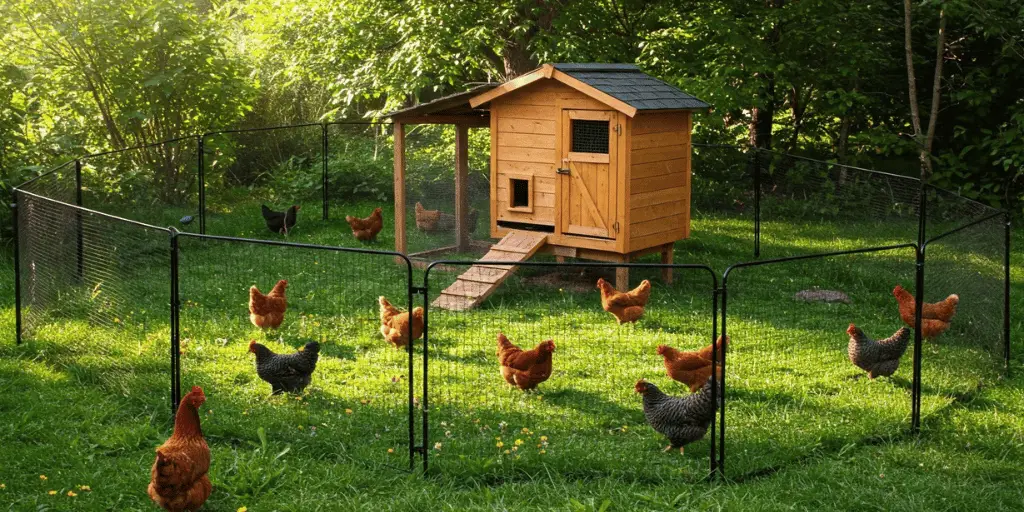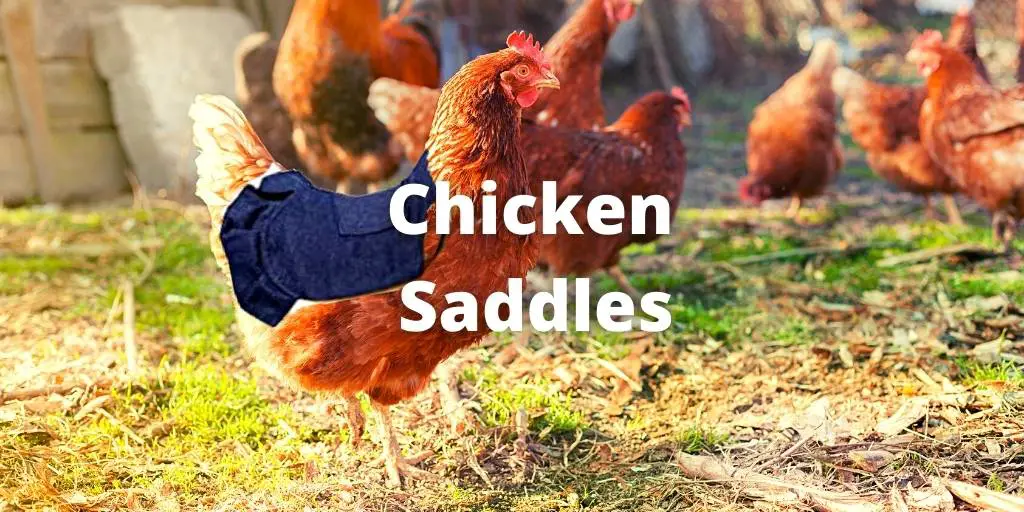Do you want to build a predator-proof chicken coop? If you are raising chickens, this is the most important thing to do.
In this guide, we have explained the common predators that threaten chickens and all the steps needed to secure a chicken coop.
Introduction (A Predator-Proof Chicken Coop)
Nowadays, more and more people are keeping backyard chickens, enjoying fresh eggs and cute birds.
But, as more people keep chickens, they’re also more aware of predators. A variety of predators see chickens as a simple source of food because of their lack of defenses.
To keep those birds safe, we need a solid plan to stop predators. All chicken owners need to know the methods of protecting their flocks from predators.
Chicken owners can reduce risks and feel safer by understanding and managing dangers.
Predators and Predator Attacks on Chickens – A Global Perspective
US and Canada
Chicken safety starts with understanding the dangers of the flock. Different places have different chicken predators, and they attack in different ways.
To protect your chickens, learn about local predators and how to deal with them.
Predators are a big problem for chickens everywhere, but the specific dangers change depending on the location.
The US and Canada have pretty similar chicken predators, though there are some local differences. Raccoons, foxes, coyotes, and birds of prey are some of the biggest dangers.
Watch out for weasels, mink, and fishers, they’re dangerous because they can get into small spaces and kill lots of birds in one go.
In the countryside, big predators like bobcats, bears, and wolves are a threat to backyard chickens.
Canada also has to deal with wolverines, lynx, and grizzlies in certain areas. Untrained house pets, even cats and dogs, can sometimes become predators.
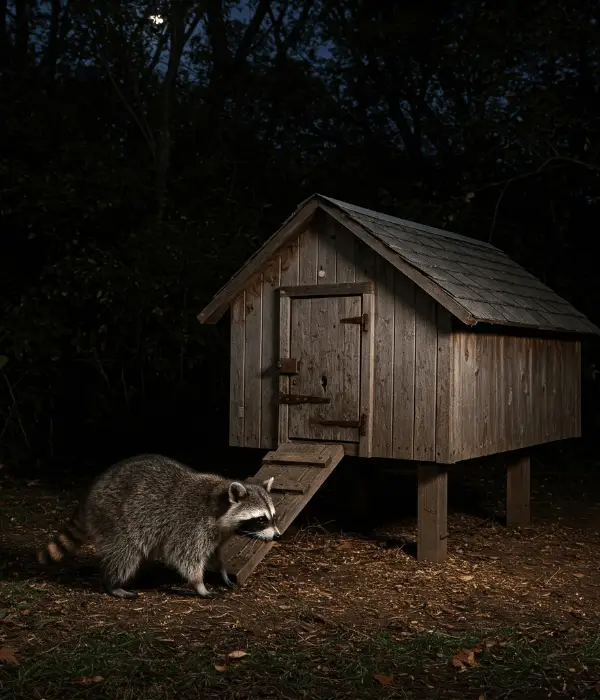
Australia
Australia has unique wildlife, so its predators are different. In Australia, foxes are a major threat, often killing lots of birds in a single attack.
Wild dogs and dingoes are a big problem, especially if you are living in bushy areas. Predators like eagles, owls, and snakes are a big threat to chickens; snakes especially go after eggs and chicks.
Big goannas are also dangerous; they eat eggs and baby chicks. Sometimes, quolls may attack chicken flocks.
In Australia, the tough and varied environment means protection needs to cover air and ground threats from predators.
Worldwide
Chickens have lots of different predators all over the world. In Europe, common predators include foxes, martens, and birds of prey like hawks and eagles.
In some parts of Asia, you’ll find chickens getting raided by wild dogs, cats, snakes, and even monkeys.
Jackals, hyenas, large snakes, and eagles are some of the predators in Africa. Some places have issues, like leopards eating chickens in villages.
Wild animals in South America, including cats and birds of prey, are a big problem for chicken farmers, along with snakes and coatis.
Keeping chickens safe needs a lot of different things, everywhere you go. Safe coops, strong fences, and keeping predators away day and night are key to avoiding losses.
Knowing what wildlife is around and adding security is key to keeping flocks safe everywhere.
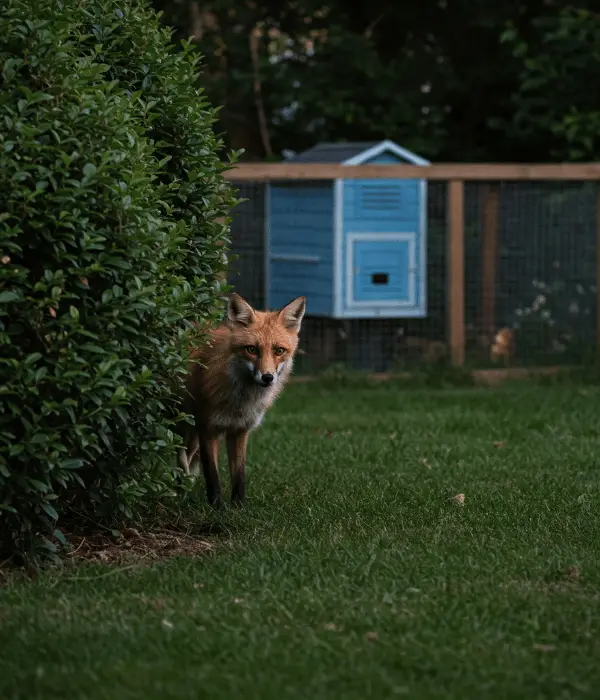
Common Chicken Predators Chart in the USA and Canada
| Predator | USA (Common/Less Common) | Canada (Common/Less Common) | Activity Pattern | Typical Attack Method |
| Raccoons | Common | Common | Nocturnal | Open latches, reach through gaps, may kill several birds per visit. |
| Coyotes | Common | Common | Crepuscular, Nocturnal | Carry off whole chickens, may dig under fences. |
| Foxes | Common | Common | Crepuscular, Diurnal | Carry off whole chickens, may eat eggs. |
| Hawks | Common | Common | Diurnal | Swoop down and carry off chickens. |
| Owls | Common | Common | Nocturnal | Attack at night, may decapitate chickens. |
| Snakes | Common | Less Common | Diurnal, Nocturnal | Eat eggs and young chicks, some larger snakes may kill adult birds. |
| Domestic Dogs | Common | Common | Diurnal | Chase, injure, or kill chickens, often for sport. |
| Domestic Cats | Common | Common | Crepuscular | Target smaller chickens (chicks, bantams). |
| Weasels/Mink/Fishers | Common | Common | Crepuscular, Diurnal | Kill multiple birds, often targeting the head and neck. |
| Opossums | Common | Common | Crepuscular, Nocturnal | Target one bird at a time, bite legs and breast, eat abdomen and vent. |
| Rats | Common | Common | Nocturnal | Eat eggs and young chicks, may injure adult birds. |
| Bobcats | Common | Less Common | Crepuscular | Kill and partially eat chickens, may carry prey away. |
| Bears | Less Common | Less Common | Diurnal | May attack coops for chickens or feed. |
| Wolves | Less Common | Less Common | Crepuscular, Nocturnal | May attack chickens if overpopulated or hungry. |
| Canada Lynx | Less Common | Less Common | Crepuscular, Nocturnal | May prey on chickens when available. |
| Cougar | Less Common | Less Common | Crepuscular, Nocturnal | Potential threat in certain regions. |
| Grizzly Bear | Less Common | Less Common | Diurnal | Significant threat in specific areas. |
| Wolverine | Less Common | Less Common | Diurnal, Nocturnal | Potential threat in northern regions. |
| Skunks | Less Common | Less Common | Nocturnal | Primarily target eggs, may kill a few chickens. |
| Eagles/Falcons | Less Common | Common | Diurnal | Swoop down and carry off chickens. |
This table outlines common chicken predators. It’s different in different places in the US and Canada.
To make good anti-predator coop plans, you need to know how they act and attack.
Essential Elements of a Predator-Proof Chicken Coop Structure
Chickens need a secure coop to stay safe from outside predators, mostly at night.
But you also need to keep your run and backyard secure using fencing for avoiding day time predator attacks.
Protecting your chickens means completely sealing the coop, all four walls, plus the top and bottom.
Predators are good at finding weak spots in coops, so build a strong one to avoid any attack.
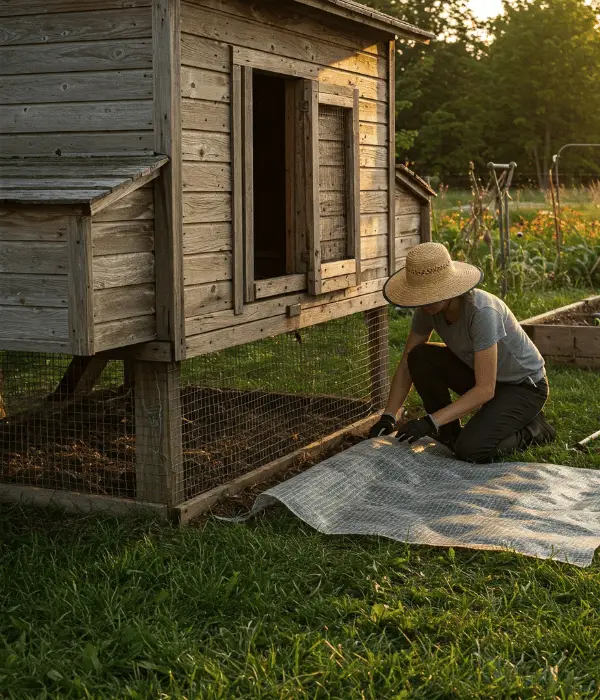
1. Foundation and Flooring: Preventing Digging from Below
The bottom of the coop is a common way for predators to get in. Animals can easily dig into chicken coops at night; it’s that simple for raccoons, foxes, coyotes, skunks, and even dogs.
Therefore, predator-proofing requires preventing predators from digging under the coop. We can use several effective approaches to counter this threat.
You should bury hardware cloth vertically around the coop’s edges. You’ll need to dig a trench a foot deep around the coop and bury the hardware cloth so it reaches the bottom of the coop.
This makes an underground barrier that keeps digging predators away. A hardware cloth apron’s a good option, especially if you already have a coop.
Bury hardware cloth 12 inches out from the coop’s base. If a predator tries digging, it’ll run into the wire mesh and stop.
Adding an apron to your coop is easier than burying a barrier, even though it’s not as effective.
For portable and small coops, cover the bottom completely with hardware cloth. Dig down 8-12 inches around the coop, line the bottom with hardware cloth, and bend the sides up to make a solid barrier.
Then, put soil on top of the hardware cloth to fill the base. Bigger coops are harder to fully close the bottom, so vertical burial or aprons work better.
You could also use concrete blocks or bricks to build the coop base. This not only creates a strong base but also forms a physical barrier that deters most digging predators.
To prevent burrowing animals from reaching the coop’s bottom, lifting the coop 12 inches or more can be helpful.
No matter the chosen method, consistently check the coop’s surroundings for digging and repair any damage.
2. Walls and Roofing: Choosing Durable and Secure Materials
Use strong stuff for the chicken coop walls and roof so predators can’t break in. You can’t use chicken wire to keep predators away, even though it’s often used for coops.
Big animals and raccoons can easily destroy it, particularly near the ground. Hawks might fly right in and hurt or kill your chickens.
Hardware cloth is the best stuff for coop walls and roofs. This stronger mesh has tiny holes, keeping most predators out.
Hardware cloth comes in different mesh sizes, but 1/4″ or 1/2″ usually works best. Small 1/4 inch openings are especially good at preventing smaller predators such as snakes, weasels, and rats from entering.
Use strong 1/2-inch staples (a pneumatic nailer helps!) to really secure the hardware cloth to the coop. If a predator really wants to go inside coop, flimsy staples won’t stop them.
Besides hardware cloth, you could also use wood or metal for extra security.
A strong roof will keep out climbers and flying predators. You can construct this from hardware cloth or solid roofing materials, depending on the specific threats and budget.
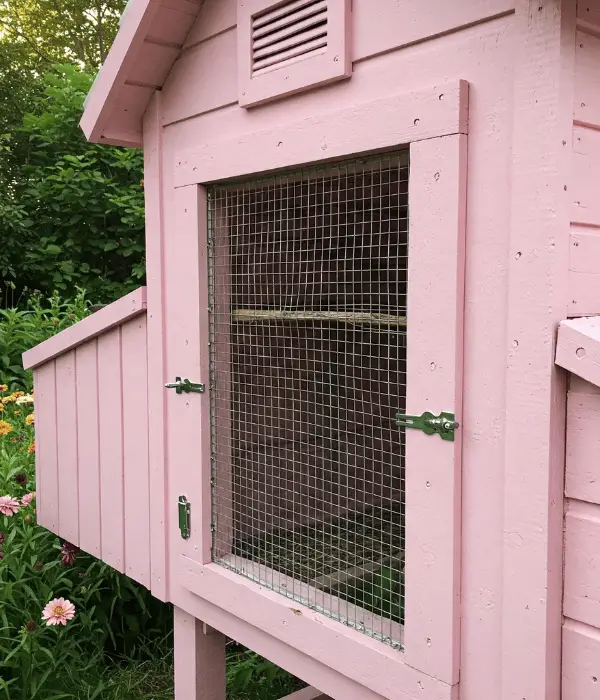
3. Ventilation and Openings: Ensuring Airflow Without Compromising Security
Good air flow keeps chickens healthy by controlling temperature and cutting down on moisture and ammonia. But, any place with air can also let predators in.
So, we need good airflow in the coop without making it less secure. Use hardware cloth (1/4 inch mesh is ideal) to cover all openings in the coop to stop predators.
Screw the hardware cloth onto the openings with washers; it’s way harder for predators to get it off than if you used staples.
Window screens won’t keep predators out; don’t rely on them for security. Make sure to check the entire coop for holes and seal them all up.
A small gap in a wooden board can provide access for small animals, such as weasels or baby chicks. Secure coop environments are best maintained via regular inspections and prompt sealing of vulnerabilities.
Creating a Safe Zone: Designing a Predator-Proof Chicken Run
A secure coop offers nighttime protection, and a predator-proof chicken run enables chickens to safely engage in daytime activities like foraging, dust bathing, and socializing.
The run must enclose the flock, preventing predators from reaching them during outdoor free-ranging.
1. Perimeter Fencing: Selecting the Right Materials and Installation Techniques
The chicken run’s perimeter fence is the initial barrier against ground predators. Similar to chicken wire, hardware cloth (usually 1/2 inch mesh) is best for its strength and durability.
Chicken wire is unsuitable primary fencing for the run because predators can easily breach it.
A fence of at least 6 feet will help keep out jumping predators such as coyotes and foxes. Since chickens can fly, a tall fence is also crucial for keeping them in their run safely.
The fence should extend a foot below the ground to deter predators from digging under it. Strong fence posts are crucial for supporting the fence and deterring larger predators.
To ensure maximum strength, use screws, and washers to firmly attach the hardware cloth to the fence posts.
To boost security, some chicken keepers opt for electric fencing around their chicken run. A low-voltage electric fence deters predators, thereby safeguarding the enclosure.
For electric fencing to work effectively and safely for your chickens and other animals, proper installation and maintenance are crucial.
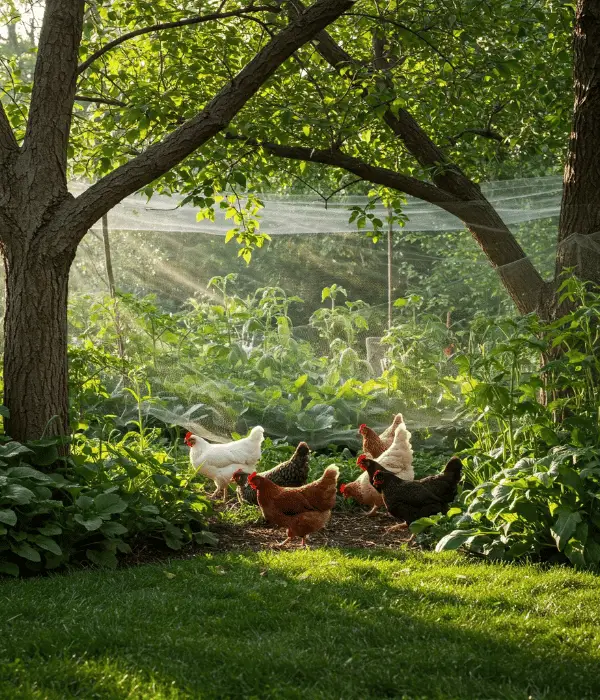
2. Overhead Protection: Shielding Against Aerial Predators
Birds of prey like hawks, owls, eagles, and falcons represent a substantial risk to chickens. Chickens are vulnerable to attacks from above in the daytime unless protected from overhead.
To best protect against aerial predators, construct a solid roof over the entire run using materials such as wood or metal.
Alternatively, hardware cloth offers strong protection against flying and climbing predators.
Aviary netting offers budget-friendly overhead protection from hawks and other predatory birds.
However, the effectiveness of nets is reduced against climbing predators that can chew through them.
Chicken safety and predator prevention require tightly installed netting. Fully covered runs provide maximum protection for chickens, enabling safe roaming without fear of aerial attacks.
The First Line of Defense: Physical Barriers and Reinforcements
Strong, well-built physical barriers are crucial for creating a truly predator-proof chicken enclosure. The safety of your flock hinges on selecting the right materials and construction methods.
1. The Importance of Hardware Cloth: Why It’s Superior to Chicken Wire
Choosing between hardware cloth and chicken wire is a major consideration when building chicken coops and runs.
Yeah, they’re both wire mesh, but they’re used for different things, especially if you’re trying to keep predators away.
Hardware cloth is way tougher than chicken wire; it’s welded, not woven. Chicken wire’s main job is keeping chickens in, not predators out.
The thinner material and bigger, hexagonal gaps let predators in easily. Those clever raccoons can easily tear up chicken wire.
Hawks can grab chickens through the openings and hurt or kill them with their talons. Small snakes and weasels can easily get through those gaps in the chicken wire.
At ground level, predators can easily tear through chicken wire. On the other hand, hardware cloth is stronger because it’s welded and has smaller holes (like 1/2″ or 1/4″).
It’s strong enough to keep most backyard predators out. The small openings stop predators, even snakes, from getting to the chickens.
Hardware cloth provides superior protection compared to chicken wire, justifying its higher cost for the safety of your flock.
2. Burying and Aprons: Preventing Predators from Digging Under
As we talked about, it’s vital to stop predators from digging under the coop and run.
Two primary methods for achieving this are burying hardware cloth vertically and creating a hardware cloth apron.
To bury hardware cloth vertically, dig a trench at least 12 inches deep around the coop and run.
So, you put the hardware cloth in the trench, all the way up from the bottom, and fasten it to the fence or coop.
So, we fill up the trench with soil to make a barrier underground. This method is highly effective because it directly blocks digging predators. But, it’s a lot more work, especially for big ones.
Making a hardware cloth apron is less work. You’ll need to dig a little trench and bury chicken wire sticking out a foot or so from your fence.
If a predator tries digging, it’ll hit this buried net and probably give up. Aprons are easier to install, especially in existing places, but might not stop determined diggers like a buried barrier would.
Some also put concrete or gravel around their chicken coops to keep diggers out. Choosing how to protect your enclosure depends on things like its size, the soil, predators around, and your budget and ability to do the work.
3. Securing Doors and Entry Points: Robust Latches and Designs
Inadequate security of doors and other entry points can compromise even the strongest coops and runs.
Raccoons, and other predators, are super smart and can open simple latches. So, secure latches are key to keeping predators out.
Make sure to have two-step lockable latches on all coop and run access points. Spring and barrel locks, needing multiple actions to open, deter predators lacking opposable thumbs.
An automatic chicken coop door is another good option. Nighttime security is enhanced by automatic chicken coop door.
Some models, like the Omlet Eglu Cube, feature innovative t-locks that are difficult for raccoons to open.
Plus, the ChickenGuard door locks itself, so predators can’t lift it up.
The Run-Chicken automatic door has a sturdy aluminum design; you can program it with timer or light-sensing options to open and close.
The ADOR1 door also uses a sprocket drive and bottom rail to stop predators from forcing it open.
Check your doors and latches regularly, no matter what kind you have, to make sure they’re working right and haven’t been damaged. Seal all doors and entryways tightly to keep predators out.
Beyond the Structure: Implementing Effective Predator Deterrents
Although a secure coop and run are essential, extra deterrents will make your flock safer by preventing predators from getting close.
1. Visual Deterrents: Motion-Activated Lights and Decoys
Lights that turn on when something moves can scare away animals at night. If a predator comes near the coop at night, sudden lights scare it off. Lights around the edge can make it less attractive to predators at night.
You can also use fake animals, like owls or coyotes, to scare them away. Other predators will likely avoid the area if one is already there.
But animals are smart cookies, and they might figure out it’s a fake threat. To keep things working well, move the decoys around every so often.
Putting reflective tape around the chicken coop might scare away birds and foxes; the flashing light freaks them out.
2. Auditory Deterrents: Alarms and Strategic Noises
Motion-sensor alarms give chicken owners a heads-up if living in high predator area. A sudden loud noise might scare predators away.
Just use noisemakers or party horns to scare away predators if they get near the flock.
It’s unclear how well ultrasonic devices keep predators away from chickens. They make super high-pitched noises to repel animals, but it looks like chickens can’t hear them.
In addition, reports show that loud noises, like predator sounds, can actually stress and scare chickens.
Playing predator sounds might keep chickens away from some places, but it won’t stop real predators and could stress them out.
3. Guardian Animals: The Role of Dogs, Geese, and Roosters
Guard animals are a great, natural way to keep predators away. Great Pyrenees, and similar dogs, are natural livestock guardians that people can train to protect chickens from predators.
I have a doberman dog in my backyard which guards my chickens. He is trained and do not attack my chickens.
A barking dog can scare off wildlife, but make sure it sees the chickens as friends, not food.
Geese are another excellent guardian animal for chickens. They’re naturally territorial and will usually honk loudly if they spot a threat, especially birds of prey.
They can’t fight big predators, but their loud warnings help protect the chickens.
Roosters also play a role in protecting the flock. They keep a close eye out and give the hens a heads-up with special calls when something’s wrong, giving them time to get to safety.
Some roosters might even fight off smaller predators to protect their hens. Llamas and donkeys, among other livestock guardian animals, are also effective at deterring predators, especially larger ones.
It all depends on your situation, local laws, and how dedicated you are to training and caring for the animal.
Regional Considerations: Tailoring Your Approach to Local Predator Threats
Regional predator prevalence should guide your choice of predator-proof cicken coop building strategies. Predators and how they act can be totally different depending on where you are.
Chicken owners need to watch out for local predators. First, find out what animals eat chickens around where you live.
Your local wildlife agencies, farm advisors, and experienced chicken owners can help. Knowing which predators are around, when they hunt, and how they attack will help you protect your flocks.
A night vision chicken coop camera lets you see what predators are around and how they act. This info can help you figure out the best security.
In places with a lot of digging predators (coyotes, badgers, etc.), you’ll really need tough underground barriers like wire mesh or concrete.
In regions where hawks and other birds of prey are common, ensuring comprehensive overhead protection for the chicken run will be a top priority.
Knowing what dangers are around will help you choose the right stuff to keep your chickens safe.
Keeping Things Safe: Regular Checks and Advance Planning
Predator-proof chicken coop making isn’t a one-and-done thing—you have to stay on top of it.
Inspect the coop and run often for any damage that could make it easier for predators to get in.
Ensure a tight hardware cloth; seal all wall and roof gaps; deter digging. Any identified issues should be repaired promptly.
Determined predators can quickly exploit small holes or weaknesses. Check your latches and locks often to make sure they work and aren’t broken.
Close the chicken coop door properly each night. Lots of predators hunt at night, so make sure your flock’s safe before it gets dark. Getting your chickens to go in the coop at night will help.
Good husbandry practices also play a significant role in predator prevention. Keep areas clean to avoid attracting predators.
Store your chicken feed in airtight metal containers so animals can’t get to it. Keep your flock safe by being smart and managing things well; this will greatly lower the chances of predators attacking.
Conclusion: Ensuring the Safety and Well-being of Your Flock
Protecting your chickens from predators is a big job. Chicken owners can keep their birds safe by understanding threats, using sturdy fences (like hardware cloth), and adding extra deterrents.
To keep the coop and run secure long-term, check on it regularly and do upkeep.
This guide won’t stop all predators, but it’ll give you a much better chance of keeping your chickens safe and happy.
I hope this guide will help you to build a predator-proof chicken coop.
